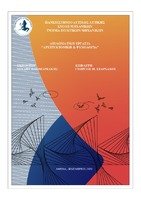| dc.contributor.advisor | Εξαρχάκος, Γεώργιος | |
| dc.contributor.author | Ηλιομαρκάκης, Μιχαήλ | |
| dc.date.accessioned | 2021-01-07T11:03:47Z | |
| dc.date.available | 2021-01-07T11:03:47Z | |
| dc.date.issued | 2020-12-16 | |
| dc.identifier.uri | http://okeanis.lib2.uniwa.gr/xmlui/handle/123456789/5535 | |
| dc.description.abstract | Η παρούσα διπλωματική εργασία έγινε με στόχο την διερεύνηση τυχόν εξαρτημένων αντιδράσεων (διαμόρφωση αντίδρασης βάσει ερεθίσματος) του χρήστη-επισκέπτη ενός χώρου, σχετιζόμενες με το γεωμετρικό σχήμα του χώρου, καθώς και τυχόν συσχετίσεις εξαρτημένων αντιδράσεων μεταξύ σχημάτων, μουσικών ρυθμών και κτιρίων. Στο 1ο κεφάλαιο γίνεται λόγος για την εξέλιξη της Γεωμετρίας και τους τρόπους κατανόησης σχημάτων. Επίσης, αναλύεται η έννοια της στερεομετρίας, παρουσιάζονται τα αναπτύγματα ορισμένων γεωμετρικών στερεών – επιφανειών και τέλος, γίνεται αναφορά στη συμβολή του Πυθαγόρα στην Αρμονία. Το 2ο κεφάλαιο είναι αφιερωμένο στην επιστήμη της Ψυχολογίας. Ξεκινά με την εξέλιξή της, γίνεται αναφορά στην ψυχανάλυση, τη βιογραφία και το σύστημα του Φρόυντ. Περιγράφονται το σύστημα του συμπεριφορισμού, η σχέση χρώματος – ψυχολογίας και η χρήση τους σε ένα χώρο, η σχέση σχήματος – ψυχολογίας με βάση προηγούμενη έρευνα και η γνωσιακή θεωρία του εποικοδομητισμού. Το 3ο και τελευταίο κεφάλαιο αφορά στο σημαντικότερο τμήμα της εργασίας, το ερευνητικό. Περιγράφεται η δομή του ηλεκτρονικού ερωτηματολογίου, παρατίθενται τα ποσοστιαία αποτελέσματα, οι κυρίαρχες απαντήσεις και συμπεράσματα/παρατηρήσεις των ενοτήτων και τέλος, στο σημείο που αναλύεται η ενότητα των κτιρίων, γίνεται μία σύντομη ιστορική αναδρομή της Αρχιτεκτονικής. | el |
| dc.format.extent | 204 | el |
| dc.language.iso | el | el |
| dc.publisher | Α.Ε.Ι. Πειραιά Τ.Τ. | el |
| dc.rights | Αναφορά Δημιουργού-Μη Εμπορική Χρήση-Όχι Παράγωγα Έργα 3.0 Ελλάδα | * |
| dc.rights.uri | http://creativecommons.org/licenses/by-nc-nd/3.0/gr/ | * |
| dc.subject | TPSH::Αρχιτεκτονική - Πολεοδομία::Αρχιτεκτονικό Σχέδιο | el |
| dc.title | Αρχιτεκτονική & ψυχολογία | el |
| dc.title.alternative | Architecture & psychology | el |
| dc.type | Πτυχιακή εργασία | el |
| dc.contributor.committee | Τσικριτσής, Αντώνιος | |
| dc.contributor.committee | Παπανικολάου, Ευάγγελος | |
| dc.contributor.department | Τμήμα Πολιτικών Μηχανικών Τ.Ε. | el |
| dc.contributor.faculty | Σχολή Τεχνολογικών Εφαρμογών | el |
| dc.subject.keyword | Αρχιτεκτονική | el |
| dc.subject.keyword | Γεωμετρία | el |
| dc.subject.keyword | Στερεομετρία | el |
| dc.subject.keyword | Ψυχολογία | el |
| dc.subject.keyword | Ψυχανάλυση | el |
| dc.subject.keyword | Συμπεριφορισμός | el |
| dc.subject.keyword | Εποικοδομητισμός | el |
| dc.subject.keyword | Διαλεκτικός δομητισμός | el |
| dc.subject.keyword | Αρμονία | el |
| dc.subject.keyword | Μουσική | el |
| dc.subject.keyword | Έρευνα | el |
| dc.subject.keyword | 3D Modeling | el |
| dc.subject.keyword | Rendering | el |
| dc.subject.keyword | Realistic | el |
| dc.subject.keyword | Στατιστική ανάλυση | el |
| dc.description.abstracttranslated | This dissertation is aimed at surveying any dependent reactions (stimulus-response conditioning) of the user-visitor of a space related to the geometric shape of space, as well as any correlation of dependent reactions between shapes, rhythms and buildings. Chapter 1 discusses the evolution of Geometry and the ways of understanding shapes. It also includes an analysis of the concept of stereometry, a presentation of the developments/evolutes of certain geometric solids – surfaces as well as a reference to the contribution of Pythagoras to Harmony. Chapter 2 is dedicated to the science of Psychology. It starts with its evolution, referring to Freud’s psychoanalysis, biography and system. It describes the system of behaviorism, the relationship between color – psychology and their use in a space, the relationship between shape – psychology based on previous research and the cognitive theory of constructivism.
The 3rd and last chapter refers to the most significant part of this project, the survey. It describes the structure of the electronic questionnaire and presents the percentage results, the dominant answers and conclusions/remarks of all sections. Finally, at the point where the section of buildings is analyzed, it makes a brief historical review of Architecture. | el |


